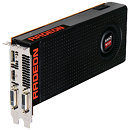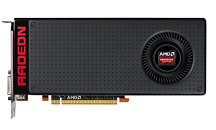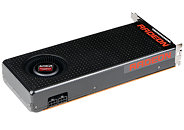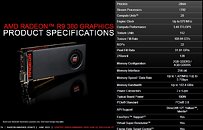- Joined
- Oct 9, 2007
- Messages
- 47,655 (7.43/day)
- Location
- Dublin, Ireland
| System Name | RBMK-1000 |
|---|---|
| Processor | AMD Ryzen 7 5700G |
| Motherboard | Gigabyte B550 AORUS Elite V2 |
| Cooling | DeepCool Gammax L240 V2 |
| Memory | 2x 16GB DDR4-3200 |
| Video Card(s) | Galax RTX 4070 Ti EX |
| Storage | Samsung 990 1TB |
| Display(s) | BenQ 1440p 60 Hz 27-inch |
| Case | Corsair Carbide 100R |
| Audio Device(s) | ASUS SupremeFX S1220A |
| Power Supply | Cooler Master MWE Gold 650W |
| Mouse | ASUS ROG Strix Impact |
| Keyboard | Gamdias Hermes E2 |
| Software | Windows 11 Pro |
In addition to the Radeon R7 300 series, AMD announced the Radeon R9 380 performance-segment graphics card. Available in 2 GB and 4 GB variants, with the 2 GB variant priced at $199, to compete with NVIDIA's GeForce GTX 960, and the 4 GB variant about $50 costlier, the card can play any of today's games at 1080p, with eye-candy maxed out, but can also play them at 1440p, with reasonably high settings.
Based on the 28 nm "Tonga" silicon, the R9 380 packs 1,792 stream processors based on the latest GCN 1.2 architecture, with 112 TMUs, 32 ROPs, and up to 4 GB of memory across a 256-bit wide memory interface. Its core is clocked at 970 MHz, with the memory at 5.70 GHz (GDDR5 effective), churning up 184 GB/s of memory bandwidth. The card's typical power draw is rated at 190W, it draws power from a pair of 6-pin PCIe power connectors.




View at TechPowerUp Main Site
Based on the 28 nm "Tonga" silicon, the R9 380 packs 1,792 stream processors based on the latest GCN 1.2 architecture, with 112 TMUs, 32 ROPs, and up to 4 GB of memory across a 256-bit wide memory interface. Its core is clocked at 970 MHz, with the memory at 5.70 GHz (GDDR5 effective), churning up 184 GB/s of memory bandwidth. The card's typical power draw is rated at 190W, it draws power from a pair of 6-pin PCIe power connectors.




View at TechPowerUp Main Site



